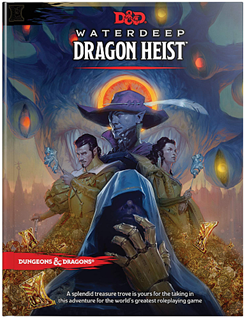I am in the process of running Waterdeep: Dragon Heist for the third time, as noted in previous blog entries. It is a strange product, where the advertising and title do not quite match the contents of the adventure. It is, at least, fully set in Waterdeep – something that causes a lot of problems when a similar naming scheme was applied to Baldur’s Gate: Descent into Avernus.
I prize innovation in adventures, although it does not always work. Dragon Heist tries to allow you to choose a villain, and then creates an adventure for each villain. This makes Chapter 4: Dragon Season one of the most innovative parts of the adventure, as it uses the same locations for several different plots, using something it calls “encounter chains”.
This is also the weakest part of the adventure. Its layout and useability suffer greatly because there’s so much dead information there. One encounter describes the location, then spends two pages describing other events before returning to the encounters needed for the Autumn plot line! It is entirely too much page-flipping or scrolling. Or, if you are clever, flicking between tabs of the browser. Meanwhile, it is meant to run as a fast-paced adventure, but one poor combat and the group need to return to rest and recuperate and – in too many cases – can’t continue with the adventure without a LOT of reworking by the DM.
This is not to say that there are not good parts in that chapter. There certainly are! However, the frazzled Dungeon Master may miss them as they frantically search for the information to keep the adventure going.
I have also been running Dragon of Icespire Peak for the first time. It occurred to me today that the individual quests in that book are very like the faction quests in Dragon Heist. I wonder how Dragon Heist would have looked if it had adopted Icespire Peak’s format?
One of the better bits of Dragon Heist is an encounter with doppelgangers. What is interesting about it is that two different factions are interested in them, and both of the factions want different things. That then allows the players to make choices. Yes, it might cause some discussions between the players, but that is a good thing.
So, could we design an adventure which leans on that? It has lots of two-page encounter areas to explore, and then over that we place a set of quests in those locations – with at least two missions for each location given by different factions?
It seems possible. It seems interesting. And it seems like we would get a lot of things wrong! But that is the point of innovation: By trying something, we learn what works and what does not, and we can do better the next time.
One interesting challenge is then integrating that sort of approach with an ongoing storyline not directly under the characters’ control. This is one of the challenges that Dragon Heist faces – the faction missions and the “heist” story line do not interact very well. How do you get them to work together?
I need to think more on that style of design!


The DMs Guild has bits and pieces to replace stock chapters to get more out of the book.
Time of the Frost Maiden seams to be a mashup for dragon Heist and the essential kit. I guess time will tell how this design philosophy works but it does appear that WOTC are going for adventure structures which DMs can make into short or long campaign depending on the level of commitment a group of players have.
There was an interview between Sly Flourish and David Baldman (on DMs Deep Dive podcast) where David noted that younger players are happy with a shorter experience 3-4 hours then move onto the next game experience not D&D.
Maybe that’s is playing out in adventure design?